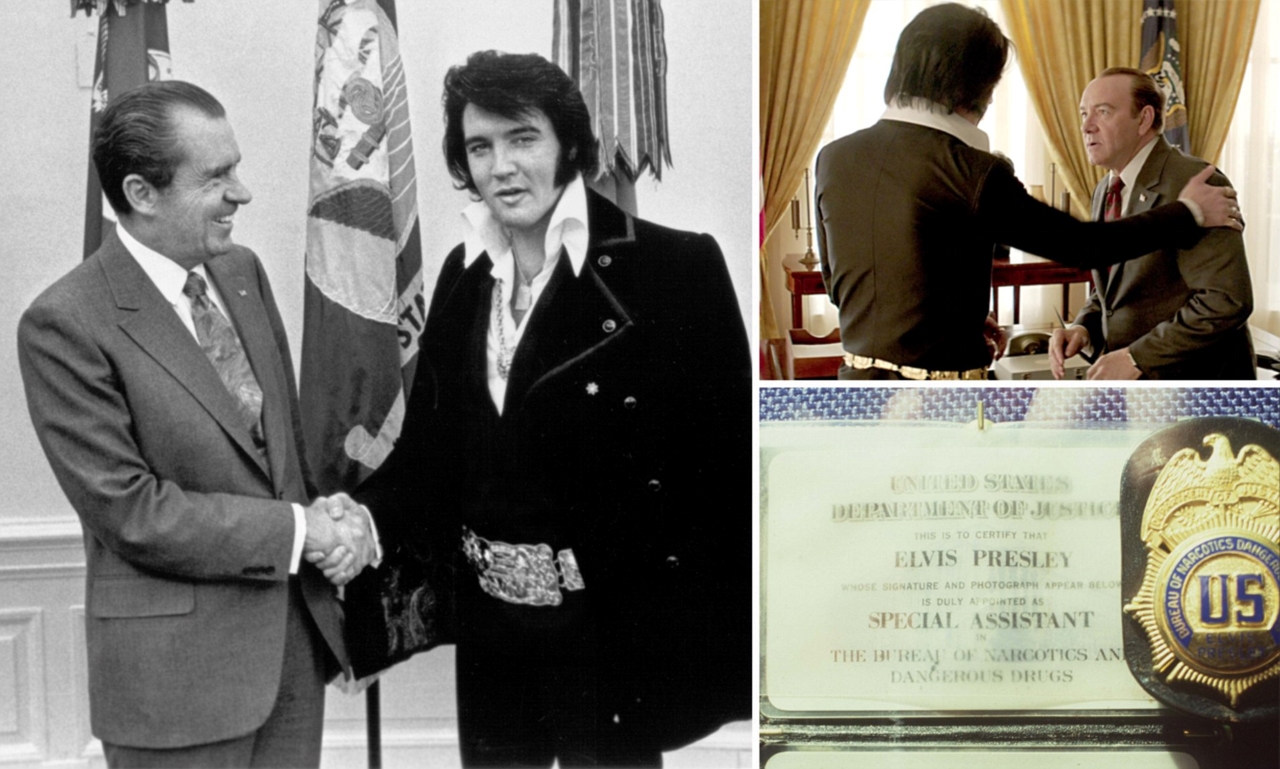🕶️ “Mr. President, I’d like to help.”
It was December 21, 1970. In a year when America was tearing at the seams—Vietnam, civil rights unrest, and a growing counterculture divide—two of the most unlikely figures in American history met behind closed doors at the White House: Elvis Presley, the King of Rock’n’Roll, and President Richard Nixon, the face of conservative political power.
What brought them together? Not music, not politics—but a letter. A handwritten, rambling six-page note from Elvis himself, penned on an American Airlines flight, declaring his concern for the youth of America and his wish to become a “Federal Agent-at-Large” in the Bureau of Narcotics and Dangerous Drugs. He wanted to fight drug abuse… wearing a badge.
And Nixon said yes.

🛬 THE KING ARRIVES IN WASHINGTON
Wearing a velvet-collared jacket, oversized belt buckle, sunglasses, and carrying a Colt .45 pistol (a gift for the president), Elvis walked unannounced into the White House gates that morning. Flanked by his friend Jerry Schilling and bodyguard Sonny West, he requested a meeting with Nixon. Most staff thought it was a prank—until they confirmed it was, indeed, the Elvis.
That afternoon, Presley was ushered into the Oval Office. What happened next would become one of the most surreal and iconic moments of American pop culture.
📸 THE PHOTO THAT WENT VIRAL—BEFORE “VIRAL” EXISTED
Elvis and Nixon shook hands. They talked for nearly 30 minutes. Elvis spoke about the Beatles being “anti-American,” expressed his concern about the rise of drug culture, and asked for a badge to help him “serve his country.” Nixon, seeing an opportunity to appeal to younger Americans, agreed.
Before Presley left, they posed for a photo—the King of Rock in flamboyant black with gold trim, and the President in a conservative gray suit, awkwardly smiling.
That photo became the most requested image in the National Archives. Not the moon landing. Not JFK. Not Martin Luther King. Elvis and Nixon.
🎭 A MAN CAUGHT BETWEEN WORLDS
Elvis’s gesture was full of contradictions. Here was a man adored by the counterculture in the 1950s, trying to distance himself from it in the 1970s. He had seen how drugs destroyed friends and fellow musicians. He genuinely believed his fame and influence could make a difference, that he could talk to kids, stop them from making the mistakes he had seen.
But it was also a deeply personal move. Elvis felt lost in the post-Beatles, psychedelic era. His career was struggling to stay relevant. He wanted meaning, purpose, and perhaps redemption.
The badge he received from Nixon became one of his most prized possessions. He wore it with pride, even flashed it to airport security. But the irony is haunting—just a few years later, Elvis himself would be battling a lethal cocktail of prescription drugs, the very substances he swore to fight.
🎬 LATER LEGACY – FROM JOKE TO CULT ICON
At the time, the press didn’t know about the meeting. It wasn’t announced until a year later. When it finally surfaced, it baffled and amused the public. Why would a rock star meet a president? And not just any president—the one most closely associated with the establishment.
The meeting inspired books, a cult documentary, and even the 2016 comedy film Elvis & Nixon, with Michael Shannon as Presley and Kevin Spacey as Nixon. While it’s often viewed with a sense of irony or satire, the meeting represented something raw and real—two men from very different worlds, each grasping for relevance, each struggling to understand a changing America.
🎵 “IF I CAN DREAM” – A SONG THAT STILL SPEAKS VOLUMES
Though not directly related to the meeting, Elvis’s 1968 song “If I Can Dream” feels like the spiritual undercurrent of this bizarre encounter. Written in the wake of Martin Luther King Jr.’s assassination, it’s a plea for hope and unity:
“There must be peace and understanding sometime…”
It was one of the rare moments where Elvis stepped into political waters, and it resonates more deeply in hindsight—especially knowing he later tried to involve himself in national causes, even in strange ways.
🕯️ TWO WORLDS COLLIDE, THEN FADE
Within a few years, both men’s lives unraveled. Nixon would resign in disgrace in 1974 following the Watergate scandal. Elvis would die in 1977 at just 42 years old, his body failing under the weight of fame, loneliness, and addiction.
But for one surreal afternoon, the King of Rock and the President of the United States sat across from each other, united by a shared desire to “fix” America, in their own strange way.
And even if history sees it as absurd, there’s something beautifully American in that absurdity—a moment where fame, power, and the desperate need for purpose collided in the most unexpected of rooms.